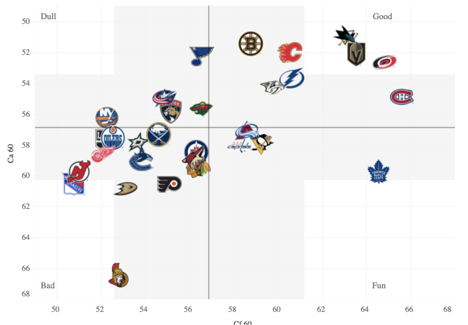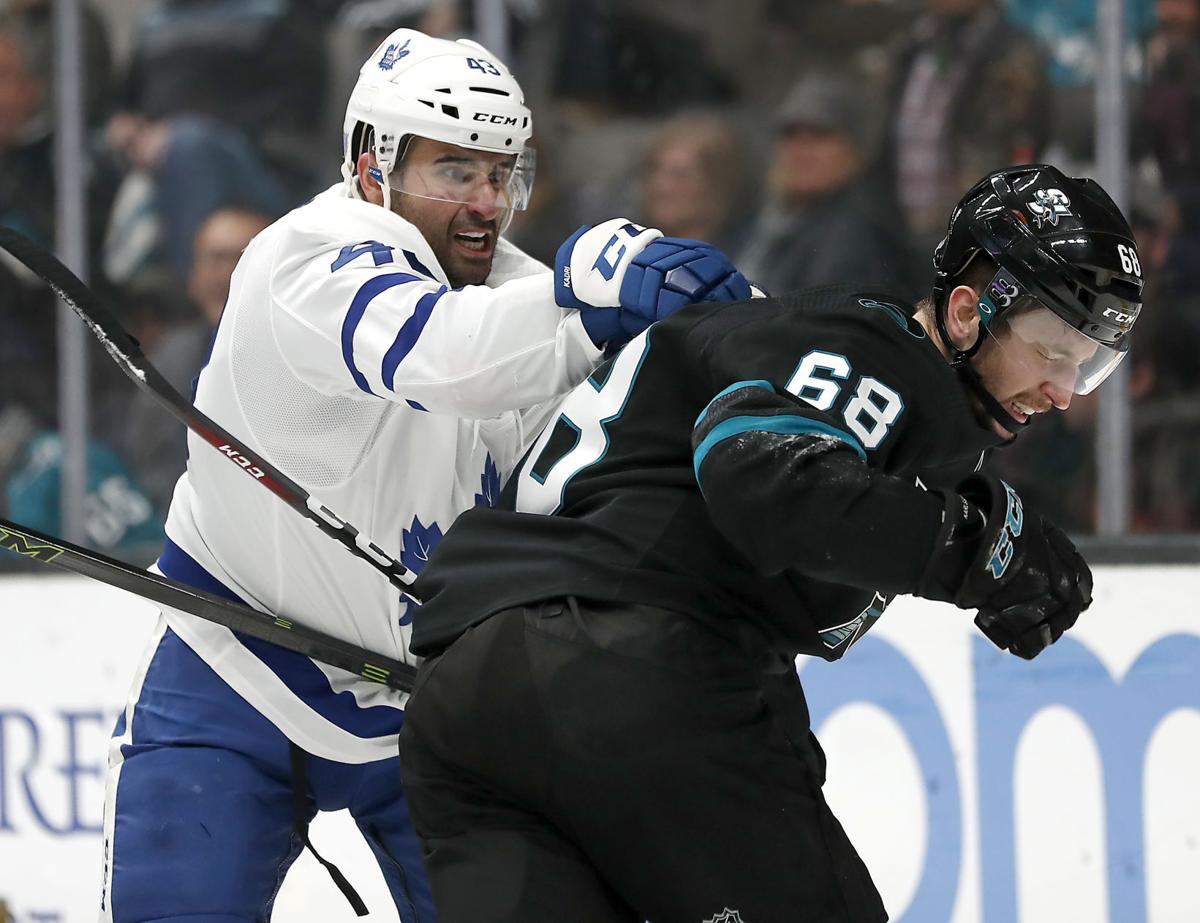The worst period for the Toronto Maple Leafs, by far, is the first period.
It’s really as simple as looking at the goal differential:
| Goal Differential | |
|---|---|
| First Period | +1 |
| Second Period | +18 |
| Third Period | +22 |
In their last 15 games, the first period has been much worse than breaking even, as they have been outscored by nine and outshot by 17 in the first period. And keep in mind it hasn’t exactly been the toughest stretch of hockey in those 15 games – Buffalo three times, Edmonton twice, Ottawa, Vancouver, and the New York Rangers, with some difficult opponents mixed in there.
It’s worth noting that this particularly poor stretch is also seeing teams take advantage of a worse than usual Leafs defense due to injuries. The early formula against the Leafs has been pretty simple – dump the puck in, forecheck hard, and force the team to breakout cleanly:
Justin Holl, not a good shift. pic.twitter.com/LERYNPp2cG
— Flintor (@TheFlintor) March 20, 2019
Earlier in that game, Brian Boyle scored a goal off a Jake Muzzin giveaway from a breakout. Teams are often feeling each other out in the first period, getting a sense of the pace and how the game is going to be played that night. For the Leafs and their “stretch” skilled hockey, it can be a difficult style to immediately break into compared to a simple dump-and-chase forecheck. We see below how the Flyers early on in the game put a puck in deep, win a few battles, and generate an excellent scoring chance:
Similarly, Ottawa has a similar recipe below: They just get pucks deep, forecheck, win battles, and pounce on mistakes.
This is an area the Leafs struggle in -– puck retrieval is not their forte, to say the least.
Where teams do get in trouble against the Leafs is sitting on leads –- they are tied for 6th in wins when trailing after the first period, and that’s not surprising as the Leafs can then dictate play and push their attack on opponents when they sit back. They can also benefit from the long change in the second period, where any sort of mistake means an odd-man rush and ensuing great scoring chance/goal (the Leafs have the third most goals in the league in the second period).
Eventually, the Leafs do generally breakthrough as the game goes on as it’s tough to pin their talent down for 60 full minutes. It’s the early parts of games that are worrisome, particularly in the playoffs, where ceding leads early is not a recipe for success.
As mentioned, it doesn’t help that the Leafs defense is currently missing two of their top three puck movers. Any sort of chance of establishing a flow to start a game is basically nixed right there as the Leafs really have one defenseman on the backend who can realistically break neutral zone traps:
What a pass by Rielly straight to Nylander's tape. Great chance. pic.twitter.com/wehB7DIKtD
— Flintor (@TheFlintor) March 15, 2019
Otherwise, it’s a choppy game where teams hold the blue line against the Leafs, make them dump it in, and generally have an easy time breaking it out from there.
At this point in the season, options are limited as to what to do. The first is hope the defense gets better (and when/how Gardiner will return is a legitimate worry in my estimation). A healthy Gardiner would go a long way toward helping move the puck through the neutral zone cleaner and controlling the pace of play better overall.
Another idea is to put together some units to start the first few shifts and try to set more of a tone. We have seen Babcock mix and match who his starting line is while generally going with the Tavares line. Perhaps in an effort to provide an early spark, they can try ‘power lines’ – e.g. putting Tavares with Matthews and Nylander first shift (or something) to try to tilt the ice immediately. They can also look at altering their neutral zone forecheck a bit by instilling more of a 1-1-3 look instead of a 1-2-2, giving their defense a bit more support off a dump-in.
Whatever they try to do to fix it, the first step is just acknowledging it’s a problem. We’ve heard the “start on time” line throughout the season, and some of it is circumstantial because they are running a defense out there that can’t move the puck due to lack of options, but they have to try something different. Games are starting, teams are tilting the ice against the Leafs, the crowd is dead silent, and they are often taking a deficit into the intermission. It won’t work in the playoffs, particularly against an excellent Bruins team.
Notes
– After the game Saturday, Babcock mentioned that they have a number of players who haven’t scored in a bit. So far in March, the team has played 11 games – Connor Brown, Patrick Marleau, and Andreas Johnsson each have one goal so far, while William Nylander, Nazem Kadri, Kasperi Kapanen, and Trevor Moore have yet to score this month (although Nylander has seven assists). One of the Leafs’ strengths heading into the season was their depth, but that’s six of their top ten that have had a pretty cold month of March so far. I have said this many times throughout the season, but they never really seemed to get into a flow with their forward group where everyone (or mostly everyone) is healthy and playing, first and foremost, and then secondly, actually clicking together.
– Relative to expectations, Nylander situation aside, the forward who has arguably struggled the most is Nazem Kadri. Here’s his production in comparison to the past few years:
| Nazem Kadri | Points/60 | Shots/60 | Points per Game |
|---|---|---|---|
| 2018-19 | 2.2 | 9.2 | .58 |
| 2017-18 | 2.5 | 9.5 | .7 |
| 2016-17 | 2.8 | 10.6 | .76 |
The production has not exactly fallen off a cliff, but the rub to this is that Kadri’s no longer in the strict matchup shutdown role that he was in previous seasons. That means that in comparison to the seasons before, they are actually creating a line that should be taking advantage of matchups and producing more, yet he is producing less. Kadri is a really good player, but he has not looked himself on a third line that calls for less responsibility and more production.
– One player that stood out in terms of production this month, on the positive side, that I did not expect? Jake Muzzin, who has eight points in 11 games playing nearly 23 minutes per game. I mentioned him in the last notebook as well and I know there has been some disappointment or negative sentiment expressed regarding his play, but he has been productive (15 points in 26 games), is adjusting to a completely different system and conference, and is playing largely with a partner that everyone has struggled to play with in Nikita Zaitsev.
– Eye-popping stat of the month so far: Auston Matthews has 55 shots on net in 11 games. He was fantastic against the Rangers, firing with 16 shot attempts, although he only recorded four actual shots on net.
– I mentioned this when the team traded for Nic Petan that one of the benefits is he’d offer cheap depth in the coming years. The team promptly signed him to a two-year deal worth under $800K per season. That said, there are some glaring questions as to where he fits and how he helps the team win playoff games. Babcock, by all indications, does not seem interested in having him on the fourth line and he is not going to play over anyone in the top nine.
– Hard to ignore what Jeremy Bracco is doing with the Marlies as he has tied the Marlies record for points in a season with 72 and there are eight games remaining in the season. Beyond that — and arguably more impressive — he leads the entire league in scoring. What a rise since last season’s 32 points in 50 games. He also just turned 22. It’s not a comparison by any means, but for some perspective, Connor Carrick led the Marlies in playoff scoring at that age with 18 points in 15 games – Nylander, Brown, Kapanen, Hyman, and Leivo all played on that team.
Quotes
“When he played with Willy and Matty he was behind the net more and digging more pucks out. Playing with John, John does more of those things as well, so you end up shooting more.”
– Mike Babcock on Zach Hyman’s growth offensively
If you think about this logically, would you rather have Hyman digging for pucks for Matthews and Nylander, or Hyman watching Tavares dig for pucks and being a shooter?
“Babcock is unafraid to challenge. Since arriving in Toronto, owner of the richest coaching contract in NHL history, he’s challenged players, evaluators, executives and himself. That’s who he is. He grinds and grinds and grinds some more.
Dubas’s ascension brought a new perspective. He may not be as outwardly passionate as Babcock, but do not underestimate his commitment to his path. I’m not talking about analytics, but valuing different players. He believes in those who’ve come through the Marlies. Several who developed there are (or should be) important members of the core for years to come. We also know that Dubas, whether at OHL Sault Ste. Marie, AHL Toronto, or now with the Maple Leafs, believes his teams should strive to win a certain way.”
– Elliotte Friedman on the Babcock – Dubas marriage
Know this has been talked about a lot in the last week but felt I still had to address it on my end of things. I don’t think there is some massive rift between them by any means. I think, like any two people in the world, they have differing views on things. Fundamentally, there are obviously some differences between the two, but I think it’s workable. Where I see the issue is the constant witch-hunt for there to be an issue. It’s like death by a million paper cuts, just constantly eating away at the relationship between the two (this is a Babcock move, this is a Dubas move, etc. etc.) and this public score-keeping and media pressure is exhausting and deteriorating. It will ultimately create an irreparable rift unless they win big. And what the real story should be here is that they both have to be better.
“That’s our team right there. We’re fast, we’re back on defence, we’re tracking and we’re coming in the offensive zone and playing below the dots and we’re utilizing our skill and letting that flow.”
– Auston Matthews on the performance against the Buffalo Sabres
The Leafs are ninth in corsi as a team and 15th in fenwick (reminder that fenwick doesn’t include blocked shots). They are in the top half of possession, but stylistically as a team, their strength is still rush offense, their speed, and creating odd-man opportunities for their skill to capitalize on.
As for being back on defense and tracking – I don’t think anyone that has watched them this season would suggest that they do that well, as they give up the ninth-most shots on goals in the league and are 16th in goals against despite having arguably a top-five goalie. There just seems to be this gap in how they want to play, or think they play, and, you know, how they actually play. Via Sean Tierney, we see a great visualization here of how the team still largely plays firewagon hockey. Lucky for them, they are skilled enough to generally get away with it (in the regular season, at least):

5 Things I Think I’d Do
1. With the team seven points behind Boston with seven games remaining, I think that the second seed and home-ice advantage is pretty well out of reach and the rest of the season should be played with that in mind in terms of managing player workload. Frederik Andersen should play four of the remaining games, giving the rest to Garret Sparks. That would include the Panthers and Senators games this week. I’d make sure Andersen gets the start against the Islanders – the Leafs owe those guys a good effort after the first two games this year.
2. I think that also applies to Ron Hainsey on defense. Calle Rosen just returned and got a game in with the Marlies. The benefits here are twofold – Hainsey gets to rest, Rosen gets his feet wet.
3. I also think this doesn’t mean, by any stretch of the imagination, that these games don’t matter. The team does not look good. In 2019, they are tied for 14th in points, have a +6 goal differential, their power play is 13th, and their penalty kill is 12th. That’s decidedly average and they are about to play the Bruins, who have the second most points in the league since the calendar turned to 2019. They need to get healthy on defense and they need to figure out the forward group because again — as stated all season — the mix is not right.
4. I still think swapping Zach Hyman and Andreas Johnsson makes all kind of sense, giving you a digger on both lines between Hyman and Tavares. It’s one thing to get away with it vs. the Sabres and Rangers of the world, but against Boston, I think you’ll need to spread out that forechecking, cycling and down low work.
5. I think that would leave the bottom six to be Marleau – Kadri – Kapanen, Moore – Gauthier – Brown. If the depth players continue to not score, you have to get Tyler Ennis back in there and see if he can provide a spark.

































